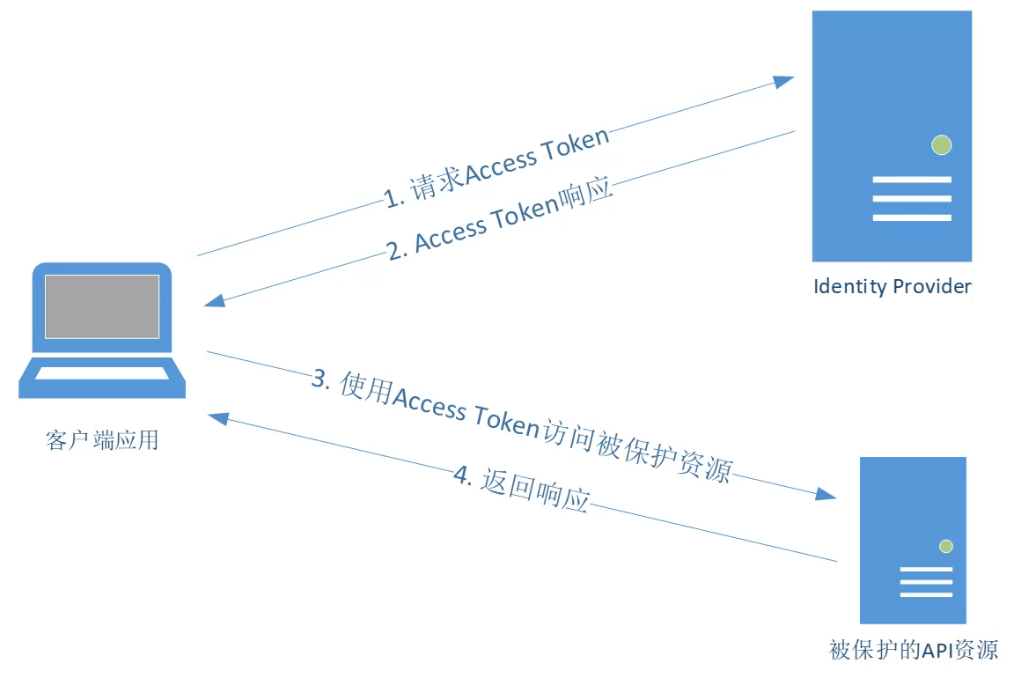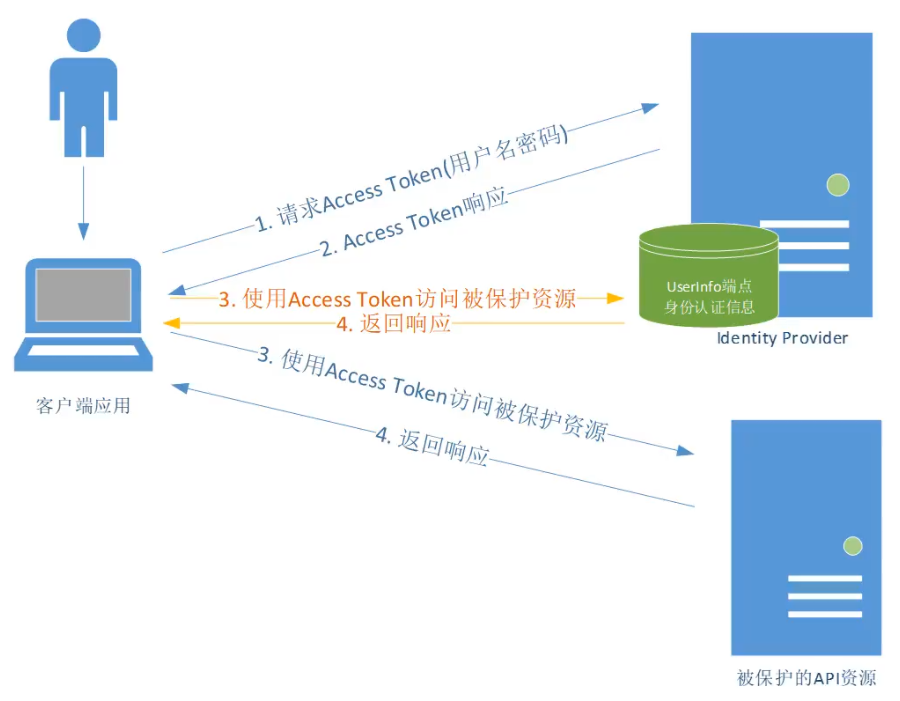原文:https://www.yuque.com/yuejiangliu/dotnet/qq7lgs
05 Resource Owner Password Credentials 授权.mp4 (93.5 MB)
一、回顾 Client Credentials
- 客户端应用不代表用户,客户端应用本身就相当于资源所有者
- 通常用于机器对机器的通信
- 客户端也需要身份认证
Token 请求:
POST http://xxx/connect/token HTTP/1.1 Accept: application/json Content-Type: application/x-www-form-urlencoded Content-Length: 116 Host: localhost:5000 grant_type=client_credentials &scope=api1 &client_id=console+client &client_secret=xxx
Token 响应:
HTTP/1.1 200 OK Date: Thu, 02 May 2019 03:52:13 GMT Content-Type: application/json; charset=UTF-8 Server: Kestrel Cache-Control: no-store, no-cache, max-age=0 Pragma: no-cache Transfer-Encoding: chunked {"access_token":"xxxxxx","expires_in":3600,"token_type":"Bearer"}
可以复制 access_token 后在 jwt.io 解码查看:
二、Resource Owner Password Credentials
- 资源所有者的密码凭证(例如用户名和密码)直接被用来请求 Access Token
- 通常用于遗留的应用
- 资源所有者和客户端应用间必须高度信任
- 其它授权方式不可用的时候才使用,尽量不用
1、在 IdentityServer 中配置客户端
配置 OpenID 相关资源,并添加 WPF Client:
public static IEnumerable<IdentityResource> GetIdentityResources() { return new IdentityResource[] { // 要请求下面几个 OpenID 相关的资源,必须先添加它 new IdentityResources.OpenId(), new IdentityResources.Profile(), new IdentityResources.Address(), new IdentityResources.Phone(), new IdentityResources.Email() }; } ... public static IEnumerable<Client> GetClients() { return new[] { // client credentials flow client ... // WPF client, password grant new Client { ClientId = "wpf client", AllowedGrantTypes = GrantTypes.ResourceOwnerPassword, ClientSecrets = {new Secret("wpf secret".Sha256())}, AllowedScopes = { "api1", IdentityServerConstants.StandardScopes.OpenId, IdentityServerConstants.StandardScopes.Profile, IdentityServerConstants.StandardScopes.Email, IdentityServerConstants.StandardScopes.Address, IdentityServerConstants.StandardScopes.Phone} } }; }
测试用的 User 已定义在 TestUsers 里:
new TestUser{SubjectId = "818727", Username = "alice", Password = "alice", Claims = { new Claim(JwtClaimTypes.Name, "Alice Smith"), new Claim(JwtClaimTypes.GivenName, "Alice"), new Claim(JwtClaimTypes.FamilyName, "Smith"), new Claim(JwtClaimTypes.Email, "AliceSmith@email.com"), new Claim(JwtClaimTypes.EmailVerified, "true", ClaimValueTypes.Boolean), ... } },
2、配置 WPF 客户端
整体界面:
记得安装 IdentityModel。
public partial class MainWindow : Window { private string _accessToken; private DiscoveryResponse _disco; public MainWindow() { InitializeComponent(); } private async void RequestAccessToken_ButtonClick(object sender, RoutedEventArgs e) { var userName = UserNameInput.Text; var password = PasswordInput.Password; var client = new HttpClient(); var disco = await client.GetDiscoveryDocumentAsync("http://localhost:5000/"); _disco = disco; if (disco.IsError) { Console.WriteLine(disco.Error); return; } // request access token var tokenResponse = await client.RequestPasswordTokenAsync(new PasswordTokenRequest { Address = disco.TokenEndpoint, ClientId = "wpf client", ClientSecret = "wpf secret", Scope = "api1 openid profile address phone email", UserName = userName, Password = password }); if (tokenResponse.IsError) { MessageBox.Show(tokenResponse.Error); return; } _accessToken = tokenResponse.AccessToken; AccessTokenTextBlock.Text = tokenResponse.Json.ToString(); } private async void RequestApi1Resource_ButtonClick(object sender, RoutedEventArgs e) { // call API1 Resource var apiClient = new HttpClient(); apiClient.SetBearerToken(_accessToken); var response = await apiClient.GetAsync("http://localhost:5001/identity"); if (!response.IsSuccessStatusCode) { MessageBox.Show(response.StatusCode.ToString()); } else { var content = await response.Content.ReadAsStringAsync(); Api1ResponseTextBlock.Text = content; } } private async void RequestIdentityResource_ButtonClick(object sender, RoutedEventArgs e) { // call Identity Resource from Identity Server var apiClient = new HttpClient(); apiClient.SetBearerToken(_accessToken); var response = await apiClient.GetAsync(_disco.UserInfoEndpoint); if (!response.IsSuccessStatusCode) { MessageBox.Show(response.StatusCode.ToString()); } else { var content = await response.Content.ReadAsStringAsync(); IdentityResponseTextBlock.Text = content; } } }
3、OpenID 预设的 4 个 Scope
5.4. Requesting Claims using Scope Values
- profile
- OPTIONAL. This scope value requests access to the End-User's default profile Claims, which are:
name, family_name, given_name, middle_name, nickname, preferred_username, profile, picture, website, gender, birthdate, zoneinfo, locale, andupdated_at.
- OPTIONAL. This scope value requests access to the
emailandemail_verifiedClaims.
- address
- OPTIONAL. This scope value requests access to the
addressClaim.
- phone
- OPTIONAL. This scope value requests access to the
phone_numberandphone_number_verifiedClaims.
4、Token 请求与响应
Token 请求:
POST /oauth/token HTTP/1.1 Host:authorization-server.com grant_type=password &username=user@example.com &password=xxx &client_id=xxx &client_secret=xxx
响应:
{ "access_token'; "MTQONjOkZmQ5OTM5NDE9ZTZjNGZmZjI3", "token_type":"bearer", "expires_in":3600, }
5、示意图
和 Client Credentials 相比:
- 多了用户角色
- 可以访问身份认证信息



